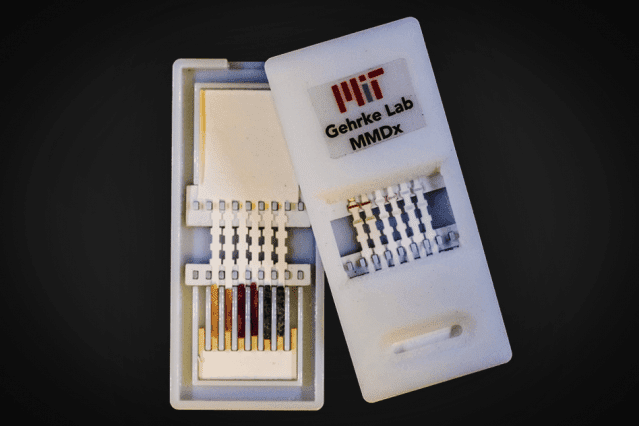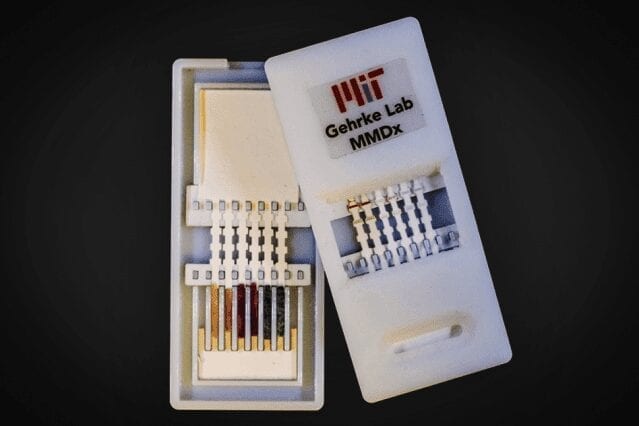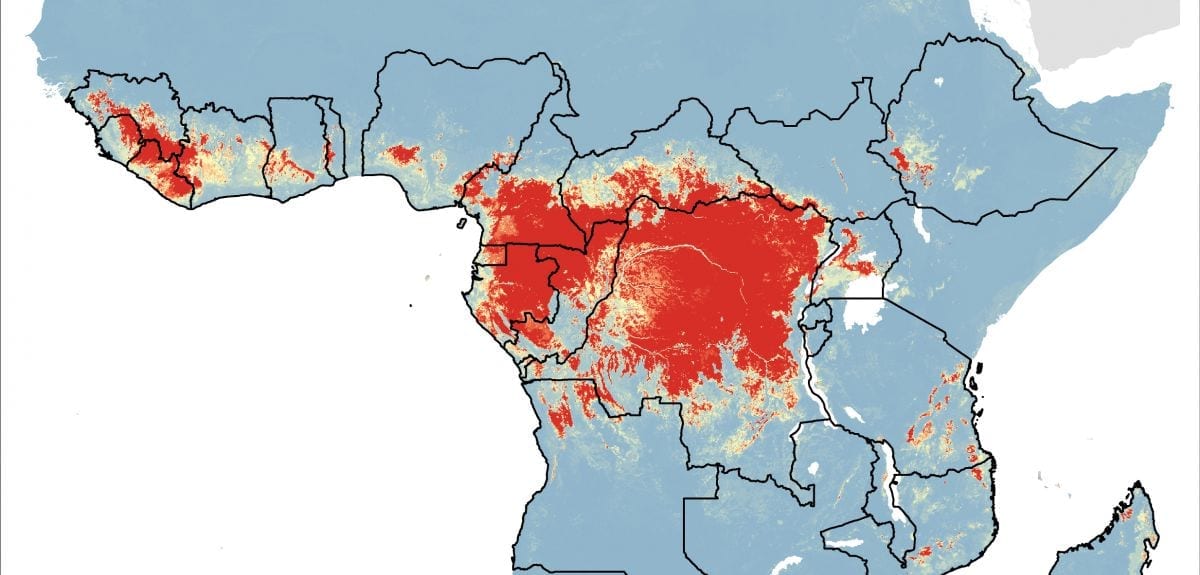
Photo courtesy of Jose Gomez-Marquez, Helena de Puig, and Chun-Wan Yen
When diagnosing a case of Ebola, time is of the essence. However, existing diagnostic tests take at least a day or two to yield results, preventing health care workers from quickly determining whether a patient needs immediate treatment and isolation.
A new test from MIT researchers could change that: The device, a simple paper strip similar to a pregnancy test, can rapidly diagnose Ebola, as well as other viral hemorrhagic fevers such as yellow fever and dengue fever.
“As we saw with the recent Ebola outbreak, sometimes people present with symptoms and it’s not clear what they have,” says Kimberly Hamad-Schifferli, a visiting scientist in MIT’s Department of Mechanical Engineering and a member of the technical staff at MIT’s Lincoln Laboratory. “We wanted to come up with a rapid diagnostic that could differentiate between different diseases.”
Hamad-Schifferli and Lee Gehrke, the Hermann L.F. von Helmholtz Professor in MIT’s Institute for Medical Engineering and Science (IMES), are the senior authors of a paper describing the new device in the journal Lab on a Chip. The paper’s lead author is IMES postdoc Chun-Wan Yen, and other authors are graduate student Helena de Puig, IMES postdoc Justina Tam, IMES instructor Jose Gomez-Marquez, and visiting scientist Irene Bosch.
Color-coded test
Currently, the only way to diagnose Ebola is to send patient blood samples to a lab that can perform advanced techniques such as polymerase chain reaction (PCR), which can detect genetic material from the Ebola virus. This is very accurate but time-consuming, and some areas of Africa where Ebola and other fevers are endemic have limited access to this kind of technology.
The new device relies on lateral flow technology, which is used in pregnancy tests and has recently been exploited for diagnosing strep throat and other bacterial infections. Until now, however, no one has applied a multiplexing approach, using multicolored nanoparticles, to simultaneously screen for multiple pathogens.
“For many hemorrhagic fever viruses, like West Nile and dengue and Ebola, and a lot of other ones in developing countries, like Argentine hemorrhagic fever and the Hantavirus diseases, there are just no rapid diagnostics at all,” says Gehrke, who began working with Hamad-Schifferli four years ago to develop the new device.
Unlike most existing paper diagnostics, which test for only one disease, the new MIT strips are color-coded so they can be used to distinguish among several diseases. To achieve that, the researchers used triangular nanoparticles, made of silver, that can take on different colors depending on their size.
The researchers created red, orange, and green nanoparticles and linked them to antibodies that recognize Ebola, dengue fever, and yellow fever. As a patient’s blood serum flows along the strip, any viral proteins that match the antibodies painted on the stripes will get caught, and those nanoparticles will become visible. This can be seen by the naked eye; for those who are colorblind, a cellphone camera could be used to distinguish the colors.
“When we run a patient sample through the strip, if you see an orange band you know they have yellow fever, if it shows up as a red band you know they have Ebola, and if it shows up green then we know that they have dengue,” Hamad-Schifferli says.
This process takes about 10 minutes, allowing health care workers to rapidly perform triage and determine if patients should be isolated, helping to prevent the disease from spreading further.
Read more: Simple paper strip can diagnose Ebola and other fevers within 10 minutes
The Latest on: Ebola Diagnosis
[google_news title=”” keyword=”Ebola Diagnosis” num_posts=”10″ blurb_length=”0″ show_thumb=”left”]
via Google News
The Latest on: Ebola Diagnosis
- Urgent considerations for booster vaccination strategies against Ebola virus diseaseon May 8, 2024 at 4:30 pm
With two endorsed and prophylactic vaccines against Zaire ebolavirus (referred to hereafter as EBOV), the number of individuals vaccinated against EBOV worldwide is estimated to range between 500 000 ...
- Brit tourist warning after horrific Ebola-like virus confirmed in Paris holiday hotspoton May 8, 2024 at 1:52 pm
A soldier in Paris has been diagnosed with Lassa fever upon returning to Paris, France from abroad - it comes as Nigeria is dealing with its worst outbreak of the fever, which can be deadly ...
- Ebola's exponential growthon May 7, 2024 at 5:00 pm
And people who have been infected by Ebola cannot pass it on to others during the incubation period (between two and 21 days). Only when they develop detectable symptoms, notably fever ...
- Horrific Ebola-like bug that causes bleeding from the eyes detected in Paris after ‘worst outbreak on record’on May 7, 2024 at 8:01 am
A CASE of Lassa fever has been reported in the Paris region. The patient, a soldier who had recently returned from abroad, is now being treated at the Bégin military hospital in Saint-Mandé, ...
- Chinese scientists create new mutant Ebola strain with horror eye symptomson May 7, 2024 at 5:35 am
Researchers at Hebei Medical University in China have used a protein that is found in Ebola alongside a contagious disease in hamsters that wiped out the rodents ...
- RedHill Biopharma’s opaganib as a therapy for Ebola virus receives Chinese patenton May 7, 2024 at 2:29 am
RedHill Biopharma’s opaganib as a therapy for Ebola virus receives Chinese patent: Tel-Aviv, Israel Tuesday, May 7, 2024, 15:00 Hrs [IST] RedHill Biopharma Ltd., a specialty bio ...
- RedHill Announces New Opaganib Chinese Patent Against Ebola Virus Valid Through 2035on May 6, 2024 at 4:01 am
and fatigue), and then progresses to "wet" symptoms (such as diarrhea, vomiting and unexplained hemorrhaging, bleeding or bruising) as the person becomes sicker. There are currently only two ...
- Chinese scientists create mutant Ebola virus in labon May 5, 2024 at 5:00 pm
While the experiment may spark fears of another lab leak, the researchers say their goal was to find the right animal models that can safely mimic Ebola symptoms in a lab setting. The study suggested ...
- CONTENT MEDICALLY REVIEWED BYon March 12, 2024 at 8:31 am
Diagnosis of Ebola virus infection involves enquiring travel and work history, and exposure to wildlife. Blood tests are performed to detect viral particles (PCR test), or to measure immune ...
- Concerns, questions as Dallas becomes 'ground zero' for Ebola in U.S.on June 14, 2023 at 3:49 am
Dallas; US: The first case of Ebola diagnosed in the United States - a man being treated in a Dallas hospital - has sparked worries that the virus that has killed thousands in West Africa could ...
via Bing News











